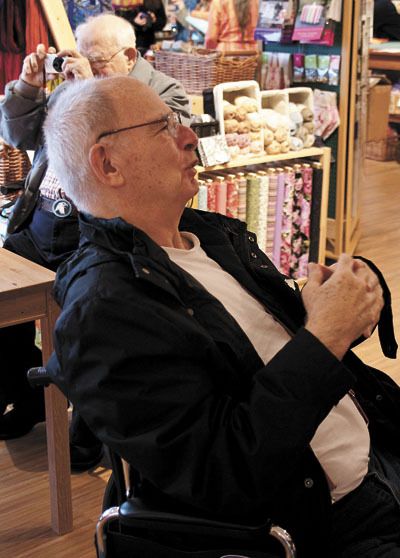On a recent rainy afternoon, several photographers gathered among the vibrant quilts and bright-colored bolts of fabric at Island Quilter. Some nestled their cameras right up to their subjects, taking the closest pictures imaginable, while others stood further apart to capture the long view.
While much about the afternoon could have passed as an ordinary photo shoot, other parts of the event were in fact remarkable: The youngest photographer in the bunch was in sixth grade, and the oldest, 93.
Those gathered were part of an intergenerational photography workshop led by Island photographers Chris Beck and Ray Pfortner. The class, which began in January, includes sixth-, seventh- and eighth-graders at The Harbor School and residents of Vashon Community Care. Twelve meetings in all, the class gathers twice a week, one day dedicated to a workshop, where photos are displayed and the students and teachers comment on them at VCC, and the other day dedicated to a field trip.
So far, the 13-member group has traveled to Vashon Island Coffee Roasterie, the Bone Factory, the quilt shop and DIG; next week they’ll head to Point Robinson. Working sometimes in student-senior pairs and sometimes alone, class members are learning about photography in the digital age as well as about each other.
“It’s always wonderful to get the generations interacting,” said Naomi Goldick-Davis, the VCC manager of social work and community outreach. “That’s my passion.”
The first seeds for this class were planted last year when several Island photographers photographed each VCC resident, culminating in a show called Perfectly Aged: Faces of Vashon.
Goldick-Davis noted then how much the residents enjoyed working with the photographers, and she began to think how to get the residents behind the camera instead of in front of it. Eventually, she approached both Beck, a volunteer at VCC, and Pfortner to see if they might teach a class. She also shared her idea with James Cardo, the headmaster at The Harbor School to see if the school could offer such a course as an elective. All parties agreed, and now the class — which will end this month — will culminate in May with a juried show at VCC, showing the best work of each student.
The course focuses mostly on composition, Beck said, and while The Harbor School students have their own cameras, most of the residents are using cameras donated via VashonAll, a popular email bulletin board.
At the quilt shop, VCC resident Ellen Johnson, who will celebrate her 94th birthday in June, was taking photos with a slim red Fujifilm camera.
“I thought it would be interesting and out of the ordinary,” she said.
At her age, she said, she has so many photos that people have sent to her over the years that she doesn’t know what to do with them all. So she’s taking the class, she said, “just for the experience.”
“I’ve enjoyed it so much,” she said, adding that she has also enjoyed working with students.
“They’re fabulous,” she said. “They’re patient. They know a lot more than I do.”
While Johnson had not taken photos for many years, she recalled her first camera: an Eastman Kodak box camera. The well- known camera company sent cameras to every 16 year old in the country that year, and she was one of the lucky recipients.
“I took a lot of photos with it,” she recalled.
Photographing a quilt in the front window, 13-year-old Lhamu Konrad said that after taking a summer camp from Beck and Pfortner, she did not hesitate to sign up.
“It was immediate,” she said. “I thought — I have to do this.”
Working with her that day was Barbara Gross, 76, who said she had never used a digital camera before and was the only one in her family without one.
“I got sick and tired of waiting for Walgreen’s to develop my pictures,” she said. “You never know if they are good or bad.”
Now, she knows, of course, if she has cut off someone’s head or lopped a person out of the picture, but she is learning much more than that.
“The teachers are fabulous; they let you take baby steps. They’re patient and they’re inspiring.”
Far back in the store, Harbor School student Julian White-Davis experimented with placing his camera up against bolts of fabric.
“I like extreme close-ups, so the viewer is wondering: What is that?” he said.
He appreciates the intergenerational aspect of the class, he noted, and has learned from the seniors.
“I really like to hear about their childhood and their past experiences,” he added.
Jack Rabourn, 74, worked largely by himself that day, one of the many seniors rolling in his wheelchair around the store, photographing with his own Nikon. In earlier years, he did a lot of photography, he said, but then health problems intervened. Now he has picked up his camera again after learning that a long stretch of chemotherapy and radiation was not effective against a brain tumor.
“I am trying to do some living things,” he said. “I am trying to get back to doing photography as an art form. I decided you just have to go forward.”
Pfortner said he most hopes the students in the class “learn how to show us their world, their vision.” Some photos, he noted, have been about ordinary life: a table set for dinner, the view out a window.
He recalled the famed Vashon photographer Oliver S. Van Olinda. “He shot the most ordinary things and because of the passage of time, they became extraordinary.”
For Beck, the class has also had considerable rewards as she and Pfortner have navigated the ins and outs of teaching photography to such a diverse group of students, including “techno kids” and seniors who are not familiar with the Internet. Members of both groups, she added, have taken some excellent photos.
“It’s absolutely fascinating to see how all of them see things,” she said. “Old or young, it’s about how you see.”



